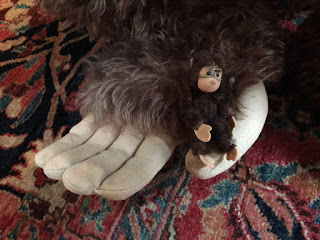 It's easy to go bananas over this great ape. He stands 150 cm tall (5 feet) and is head and arm jointed. He is made of really long, chocolate brown mohair. His face, feet, ears, and hands are made from tan felt and are detailed with light airbrushing to give them additional dimension and depth. He has typical Jocko chimp detailing, like pert eyes set into eye pockets, a white mohair chin, and an open, smiling mouth - albeit on a huge scale. Jocko has an internal rod metal skeleton for stability, and he stands on two flat feet. He is solidly stuffed with excelsior, which must have taken several strong men weeks if not months to complete. According to the Sortiment book, this big boy was produced in this size only in 1960 and 1967. Here on the left is the Steiff Display Animal catalog page from 1967 featuring him.
It's easy to go bananas over this great ape. He stands 150 cm tall (5 feet) and is head and arm jointed. He is made of really long, chocolate brown mohair. His face, feet, ears, and hands are made from tan felt and are detailed with light airbrushing to give them additional dimension and depth. He has typical Jocko chimp detailing, like pert eyes set into eye pockets, a white mohair chin, and an open, smiling mouth - albeit on a huge scale. Jocko has an internal rod metal skeleton for stability, and he stands on two flat feet. He is solidly stuffed with excelsior, which must have taken several strong men weeks if not months to complete. According to the Sortiment book, this big boy was produced in this size only in 1960 and 1967. Here on the left is the Steiff Display Animal catalog page from 1967 featuring him. Now let's take a brief "guided tour" of Jocko.
As you can see, he really is a very big dude indeed. Here he is pictured with Steiffgal. Just for reference, Steiffgal is 5'5". It is Steiffgal's best estimate that if indeed he were real and made from muscle and bone, his girth and proportions would put him between 300-400 pounds. He actually weighs about 25 pounds.
His handsome, proportionally large face is simply irresistible - and always smiling! It measures 22 inches from his chin to the top of his head, and 20 inches ear to ear.
Here is a close up of his dimensional and very lifelike ear. You can see the smallest 4 inch Jocko resting on it so you get an idea of its scale. Big Jocko's ears measure 5.5 inches high each.
And here is a close up of his hand. Again, the smallest Jocko helps to put his size in context. His hands measure about 8 inches long and 9 inches wide.
Jocko has flat felt feet to help him stand (with a little help.) They measure 14 inches long and 8 inches wide.
As you can see, Jocko is extremely photogenic. If you are in the Maryland area on September 28th and 29th, 2018, Jumbo Jocko and Steiffgal will be attending the United Federation of Doll Clubs (UFDC) Region 11 conference in Towson, MD. We will be manning a Steiff table in the salesroom with lots of Steiff temptations for doll and Steiff collectors alike. Jocko looks forward to meeting as many Steiff fans as possible at this great event, and is available for once-in-a-lifetime selfies. Click here for more information on this UFDC celebration.
Steiffgal hopes this discussion on her Studio Jocko has been a larger than life experience for you.
Have a question about one of your Steiff treasures? Let's talk! Click here to learn more!



























